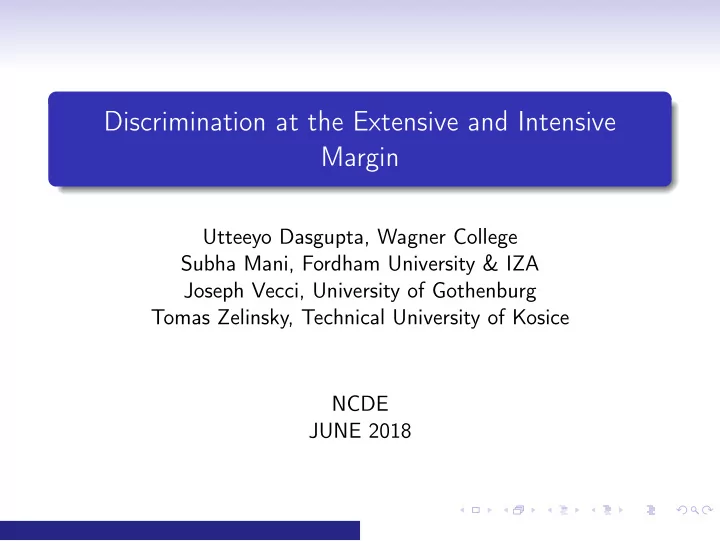

Discrimination at the Extensive and Intensive Margin Utteeyo Dasgupta, Wagner College Subha Mani, Fordham University & IZA Joseph Vecci, University of Gothenburg Tomas Zelinsky, Technical University of Kosice NCDE JUNE 2018 Discrimination
Introduction Discrimination is extremely costly to society: • WWII, Rawandan Genocide, Rohingya Muslims in Myanmar. • Lower wages, worker dis-satisfaction, feeling of being unfairly treated. Long-standing interest in understanding the prevalence and causes of discrimination (Becker, 1957): • out-group/minority - gender, caste, religion, ethnicity. • taste based - pure distaste or dis-preference for the out-group. • statistical - signal extraction problem. Discrimination
Literature Excellent reviews on both the prevalence and sources of discrimination: • Correspondence studies - Bertrand and Duflo, 2016. • Lab experiments - Lane, 2016. Mostly focuses on discrimination at the extensive margin/looking for a job. Extensive vs. intensive margin differences in secondary data can be attributed to selection. Discrimination
Objectives Prevalence and sources of discrimination using a unique lab-in-the-field experiment: • Extensive and Intensive margin. • Taste vs. statistical discrimination. • Comparing extensive vs. intensive. We do so using a sample of high school students. Play a modified coordination game where the payoff matrix is fixed. These findings are key for formulating anti-discriminatory policies. Discrimination
Context Our goal is to study discrimination towards Roma, the largest minority in Europe. In EU member states 85% of Italians and 66% of French hold an unfavorable view of Roma. 60% of Slovak pupils reported an objection when asked to share the same desk with a Roma (Slovikova, 2012). EU has spent 7 billion dollars towards anti-discriminatory interventions and policies. Discrimination
Experimental Protocol Each session in a school is randomly assigned to receive the extensive design or intensive design. Each session is further randomized into treatments 1-4 under the extensive design or treatments 1-3 under the intensive design. The experiment was conducted in Eastern Slovakia, during June and September 2017. Our sample includes 721 adolescents (aged 15-18) from the majority population, Slovaks. Each session lasted around 45 minutes. Each subject received a fixed show up fee of 2 Euros in addition to payments from the experiment. Average payouts were approximately 6 Euros. As most of the subjects were not adults, subjects received their rewards in the form of a generic gift card (https://www.up-slovensko.sk/gift-coupon/). Discrimination
Extensive Margin Design Protocol The goal of this experiment is to elicit subjects underlying preferences (taste or statistical) for working with employees of certain characteristics (ethnicity and or type). Employees (Roma, Slovak, and Hungarians) decide on effort level Table EE 58 Employees fill background questionnaire Table 1 Employers (Slovaks) first choose between list A and list B Table 2 Employers (Slovaks) next decide on whether to make a high wage offer or a low wage offer. Table 4 Discrimination
Extensive Margin Treatments Back Discrimination
Intensive Margin Design Protocol The goal of this experiment is to elicit on-the-job discriminatory behavior. Employers first choose between list A and list B Table 3 Employers are matched with an employee. Employers next decide on whether to make a high wage offer or a low wage offer. Table 4 Discrimination
Extensive and Intensive Margin: Hypothesis Discrimination
Extensive Margin: Any discrimination Option A: R-H-H-R Option B: S-H-H-S Discrimination
Extensive Margin: Taste-based discrimination without cost Option A: R-H-R-S (all high type) Option B: S-H-R-S (all high type) Discrimination
Extensive Margin: Taste-based discrimination made costly Option A: R-H-H-R (all high type) Option B: S-H-H-S (only S low type) Discrimination
Extensive and Intensive Margin: Results Discrimination
Discussion Discrimination is prevalent at both the intensive and extensive margin, though much larger at the extensive margin (70%) than intensive margin (17%). When there is no cost to the discriminator, taste based discrimination is large and significantly different from zero (extensive: 60%, intensive: 14%). As we make taste-based discrimination costly, it completely disappears. Statistical discrimination exists, but is small in magnitude and not statistically significant. Anti-discriminatory policies that make discrimination costly can have an important role in eliminiating prejudice in society. Discrimination
Background Questionnaire Back Discrimination
Real effort task Back Discrimination
Intensive Margin Treatments Back Discrimination
Coordination Game Back Discrimination
Intensive Margin Treatments Back Discrimination
Recommend
More recommend